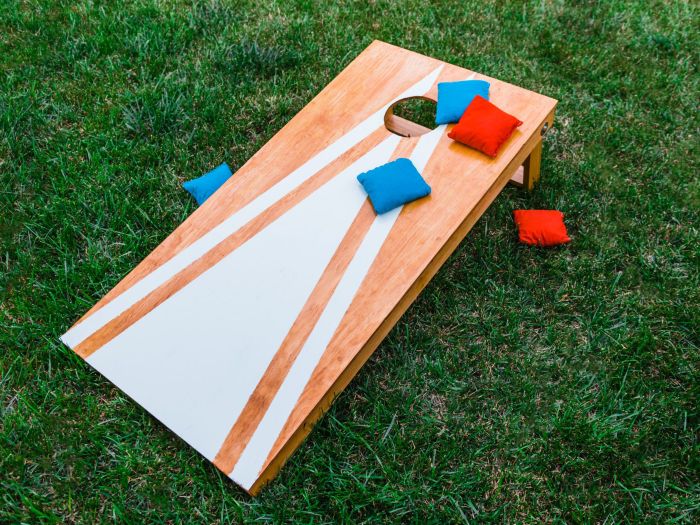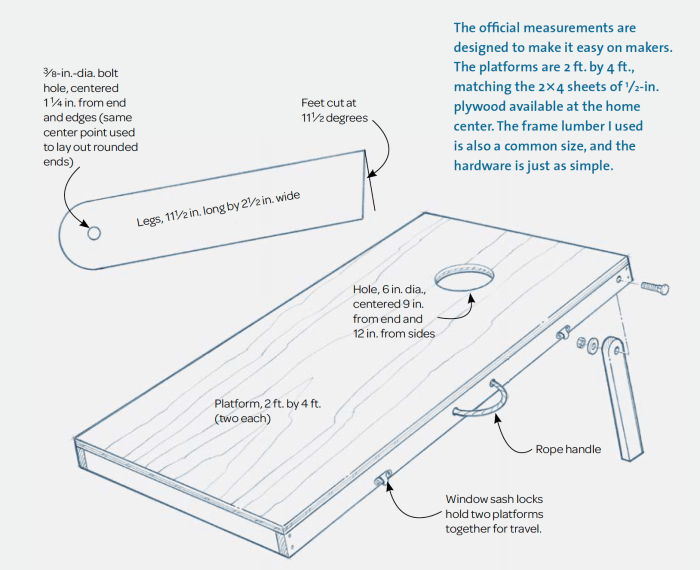Diy corn hole game – DIY Cornhole Game: Ready to build your own backyard fun? Cornhole is a beloved game, perfect for gatherings, tailgates, or simply enjoying some friendly competition in your own backyard. You don’t need to be a master craftsman to create your own set, and the satisfaction of building it yourself is an added bonus. This guide will walk you through the process, from design considerations to decorating tips, so you can create a unique and personalized cornhole game that you’ll cherish for years to come.
Cornhole, also known as beanbag toss, is a classic outdoor game that has enjoyed a resurgence in popularity. The game’s simple rules and easy setup make it a hit with people of all ages. Whether you’re a seasoned cornhole player or just starting out, building your own set allows you to personalize the game and create a unique addition to your outdoor space. From choosing the right materials to adding your own creative touches, this DIY project is a fun and rewarding way to enhance your backyard entertainment.
Introduction to DIY Cornhole Games

Cornhole, a beloved backyard game, has surged in popularity across the United States and beyond. Its simple rules, engaging gameplay, and versatility make it a perfect choice for gatherings of all sizes. From casual backyard barbecues to competitive tournaments, cornhole has captured the hearts of players of all ages and skill levels.
History of Cornhole, Diy corn hole game
The origins of cornhole can be traced back to the early 20th century, though its exact birthplace remains a subject of debate. Some believe it originated in the Midwest, where farmers used wooden boards and beanbags for entertainment. Others trace its roots to Germany, where a similar game called “Bags” was played in the 18th century. Regardless of its precise origins, cornhole has evolved over the years, becoming a widely recognized and enjoyed pastime.
Basic Rules of Cornhole
Cornhole is played by two teams of one or two players each. The game is played on a rectangular board with a hole in one end. Each team stands at opposite ends of the playing area, aiming to toss beanbags into the holes on the opposing team’s boards. Points are awarded for bags that land in the hole (three points) or on the board (one point). The first team to reach 21 points wins the game.
The team with the most points at the end of a round scores the difference between their points and their opponent’s points. For example, if Team A scores 15 points and Team B scores 10 points, Team A would score 5 points for the round.
Design Considerations

Designing and building a cornhole game is a fun and rewarding project. You can personalize your game with unique designs and materials. To get started, consider the following design considerations.
Cornhole Board Dimensions
The standard cornhole board dimensions are 48 inches long, 24 inches wide, and 3 inches deep. These dimensions are crucial for ensuring the game’s regulation play and fair competition. While you can customize the size to some extent, it’s generally recommended to stick to the standard dimensions for optimal gameplay. The standard size ensures that the game is challenging but fair for all players.
Cornhole Board Materials
You can use various materials to construct the board. Some common materials include:
- Plywood: This is a popular and affordable option for building cornhole boards. Plywood is durable, easy to work with, and readily available at most hardware stores.
- MDF (Medium-density Fiberboard): MDF is another suitable material for cornhole boards. It is smooth, dense, and provides a consistent surface for painting and finishing.
- Cedar: Cedar is a beautiful and naturally resistant wood that can add a touch of elegance to your cornhole boards. It’s known for its durability and pleasant aroma. However, cedar is a more expensive option than plywood or MDF.
Cornhole Leg Materials
For the legs, you can choose from a variety of materials. Some common options include:
- 2x4s: These are readily available and inexpensive. You can use them to build sturdy and stable legs for your cornhole boards.
- PVC Pipe: PVC pipe is a lightweight and durable option for building legs. It is also relatively easy to cut and assemble. You can find PVC pipe in various diameters at hardware stores.
- Metal: For a more industrial look, you can use metal tubing to construct the legs. Metal legs can be very durable and can be customized with different finishes.
Cutting and Assembling the Board
To cut and assemble the cornhole board, you’ll need the following tools and materials:
- Circular Saw or Table Saw: To cut the plywood or MDF to the correct dimensions.
- Measuring Tape: To accurately measure the dimensions of the board and legs.
- Pencil: To mark the cutting lines on the plywood or MDF.
- Wood Glue: To secure the pieces of wood together.
- Screws or Nails: To further secure the pieces of wood together.
- Sandpaper: To smooth out the edges of the board and legs.
- Cut the Board: Cut two pieces of plywood or MDF to the dimensions of 48 inches long, 24 inches wide, and 3 inches deep. Ensure the cuts are precise and square for a clean and stable board.
- Attach the Legs: Cut four pieces of 2x4s, PVC pipe, or metal tubing to the desired height. Attach the legs to the bottom of the board using wood glue and screws or nails. Make sure the legs are evenly spaced and securely attached.
- Sand the Edges: Sand the edges of the board and legs to smooth out any rough spots. This will prevent splinters and create a more professional-looking finish.
- Paint or Stain: Paint or stain the board and legs to your liking. You can use a variety of colors and finishes to personalize your cornhole game.
- Add the Hole: Mark the center of the board and drill a 6-inch diameter hole. This hole should be centered 9 inches from the top edge of the board.
- Add the Cornhole: You can use a standard 6-inch diameter PVC pipe or a custom-made cornhole ring to complete your board.
Creating the Playing Surface: Diy Corn Hole Game

The playing surface of your cornhole game is the heart of the game. A smooth and even surface ensures fair play, preventing the cornhole bags from bouncing erratically or getting stuck. This section delves into the techniques for achieving a flawless playing surface.
Painting or Staining the Board
Painting or staining the board not only enhances its aesthetic appeal but also protects the wood from the elements.
- Choosing the Right Paint or Stain: Select a paint or stain that is specifically designed for outdoor use. This ensures durability and resistance to fading, chipping, and moisture. Look for options that are water-based, as they are generally safer and easier to work with.
- Preparation: Before applying paint or stain, thoroughly sand the board to create a smooth surface. This allows for even application and prevents the paint or stain from pooling or unevenly spreading.
- Application: Apply the paint or stain in thin, even coats. Allow each coat to dry completely before applying the next. This ensures a smooth finish and prevents the paint or stain from cracking or peeling.
- Finishing Touches: Consider adding a protective sealant to the painted or stained surface. This helps protect the finish from scratches, UV rays, and moisture, ensuring a longer lifespan for your cornhole game.
Applying Protective Coatings
Applying a protective coating to the playing surface is essential for maintaining its integrity and extending its lifespan.
- Types of Protective Coatings: Several types of protective coatings are available, including polyurethane, varnish, and epoxy. Each offers different levels of durability and protection. Polyurethane is a popular choice due to its durability and water resistance. Varnish provides a glossy finish and protects against UV rays. Epoxy is a high-performance coating known for its strength and durability.
- Application Techniques: Apply the protective coating using a brush, roller, or spray gun. Ensure that the coating is applied evenly and in thin coats. Allow each coat to dry completely before applying the next.
- Maintenance: To maintain the protective coating, periodically clean the playing surface with a mild soap and water solution. Avoid using harsh chemicals or abrasive cleaners.
With a little time, effort, and creativity, you can build a DIY cornhole game that will provide hours of entertainment for you and your friends. From choosing the right materials to adding your own unique designs, this project is a fun and rewarding way to personalize your backyard and create a game that reflects your individual style. So gather your tools, get creative, and get ready to enjoy your very own custom-made cornhole set!
A DIY corn hole game is a great addition to any backyard gathering, and adding a bit of ambiance with homemade citronella candles can enhance the experience. You can learn how to make your own diy citronella candles with simple ingredients and instructions. Not only will they keep pesky bugs away, but they also create a relaxing atmosphere, making your corn hole tournament even more enjoyable.
